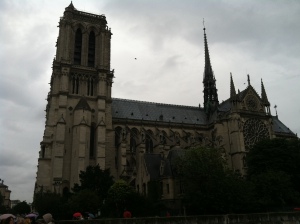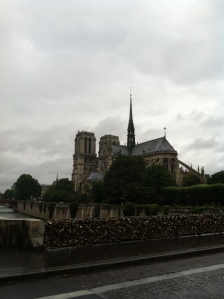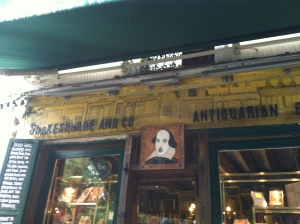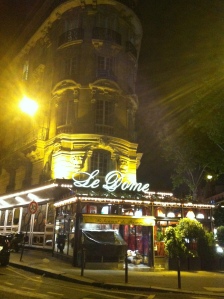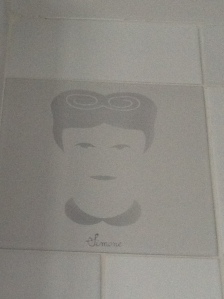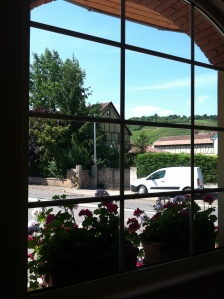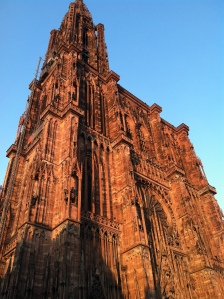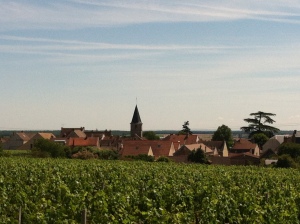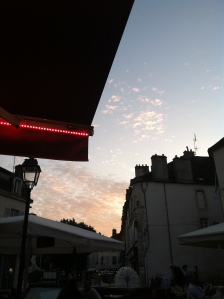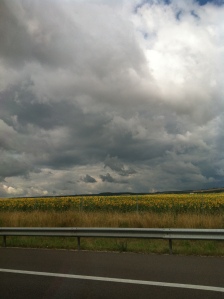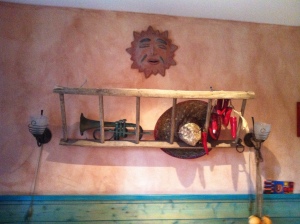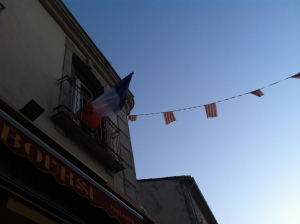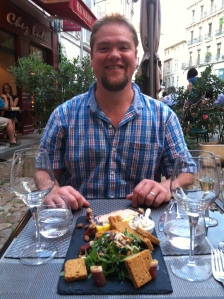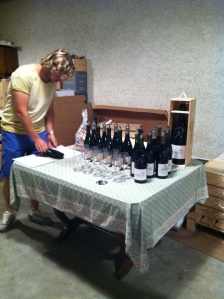We had just one day in Paris, and we planned to make the most of it. What we didn’t plan on was…rain. It started drizzling during breakfast at the hotel, and by the time we were ready to head out, it was coming down pretty hard. We didn’t let that stop us from hopping on the metro, destination Notre-Dame de Paris and Shakespeare & Company Books.

These signs — warning against the dangers of getting stuck in the doors on the Metro — never fail to amuse me.
The cathedral was just as gorgeous in the rain, perhaps even more than ever in a somber, grey way.
We wandered along the Seine for a while, dodging puddles and raindrops, and admiring the changing view from every angle.
Now I am going to insert a little PSA here: people, it’s time to stop with the “love locks” trend. The “love lock” trend involves writing your initials on a padlock, attaching it to a bridge, and throwing the key into the water. Sounds cute, right? Well, it was cute enough when there were a few locks on the Pont des Arts a decade ago. Today, every. single. inch. of every bridge in Paris is overflowing with the things, causing damage to the bridges as well as to the river below. So next time you’re in Paris, enjoy the view and a romantic moment with your loved one, but don’t get sucked into the love lock trend!
Rant over. Time for more pictures:
As our feet were getting uncomfortably soggy, we decided to dry out at Shakespeare & Company Books. This English-language bookstore is a haven for literature lovers, with two floors overflowing with books, used and new, as well as an on-site library with cozy corners to sit and read. I curled up with a bound edition of 1850’s Harper Magazines and marveled at the line drawings of “Ladies Fashions” including whalebone corsets and hoop-skirts alongside verses by Longfellow. It was like a time capsule from another world.
Our feet somewhat drier and the rain slowing, we set out in search of the most beautiful café in Paris. We had stumbled on this café when we first visited Paris together years ago and stayed in a crumbling old hotel in the Bastille quarter. From the outside, it looked like any typical Parisian bistro, with the standard rattan chairs, red awning and bored waiters. But inside were the most incredible original Art Nouveau mosaics, as well as a particularly well-stocked bar. Finding one particular café out of the thousands in Paris, without knowing its name or exact location, would be like finding the proverbial needle in the haystack.

Le Bistrot du Peintre (from their website).
And yet, we did find it, somehow: Le Bistrot du Peintre, 116 Avenue Ledru-Rollin. We stayed for a long, leisurely, and yet relatively light lunch of salad and charcuterie, a white wine and Irish Coffees to ward off the damp chill.
With lunch and most of the afternoon over, we began planning dinner: one ultimate feast for an unforgettable end to our trip. Since were staying in Montparnasse, we decided it needed to be in one of the formidable classic cafés on the Boulevard. Still craving seafood, we made a reservation at Le Dôme.
Le Dôme was one of the first literary cafés on the Boulevard Montparnasse, and it was famous as a gathering place for artists, writers, and socialites throughout the 20th century. It’s fun to imagine Ernest Hemingway and Ezra Pound lounging at the next table. The place (and the décor) might be steeped in history, but the food and the service are anything but past their expiration date.
Once again, we ordered everything.
We were seated in the enclosed patio, draped in red velvet curtains straight out of the Belle Epoque. We asked about the impressive list of oyster options, and our server kindly offered to bring us a selection of six different varieties. He explained that oysters are like cheese, with endless variation in flavor, texture, and style in oysters from different regions.
As we happily dived into our first oysters, we noticed that the meat was still attached to the shell, not loose as is the custom in the US. We both sat there awkwardly trying to free the osyter with our tiny forks, until our ever-helpful server came over and showed us how to cut the foot with the small knife provided. Apparently, this is the French style of serving oysters, meant to keep them alive and fresh until the very moment of consumption. He was right that the foot is the best part, sweet and meaty with a condensed flavor.
The oysters could have been a meal in themselves, but we couldn’t stop there: roast sea bream and a grilled Breton lobster were next, each wildly flavorful and perfectly prepared.
While we were savoring our meal, our server had been going from table to table inquiring whether they cared for a slice of their famous millefeuille for dessert. When he got to our table, the answer was a resounding bien sûr, in keeping with our tradition of always ordering the house specialty. We were glad we did: out came a towering slice of impossibly fine pastry sandwiched between layers of heavenly cream. We also had the gâteau moelleux (molten chocolate cake), because Drew said he had never had one (I think he just wanted his own dessert so I wouldn’t steal it all).
It truly was the feast to end all feasts, and the perfect finale to an incredible two weeks. We had eaten and drank our way around half of France. We were tourists of our own kind, not there to see the sights so much as to see where and how the locals ate and drank. It was a honeymoon after two wonderful years of marriage, waiting and planning and saving for this one epic voyage.
We never wanted it to end, but in reality, we were ready to get back to some level of normalcy. A good vacation should leave you at least somewhat ready for home, in my opinion.
The next morning, Drew had a flight back to California, and I had a train to the Côte d’Azur where I would stay another week and visit friends there. I will tell you about my solo travels next week, although I have to admit they will not be as over-the-top as the last two weeks have been!


